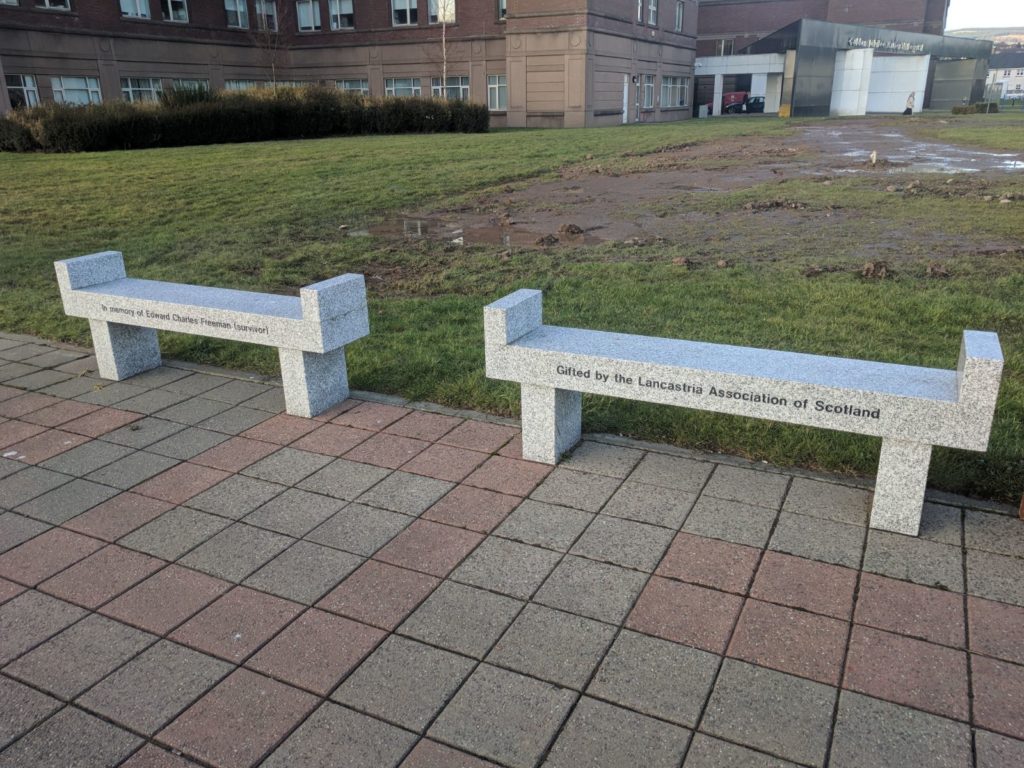
Text taken from the model of the of the HMT Lancastria in the reception of the Golden Jubilee Hospital (February 2018):
BUILD
The keel of SS THRRHENIA was laid on 2 June 1919 by William Beardmore and Company Limited, Dalmuir.
The site of the old Beardmore yard is now the home of the Golden Jubliee Hospital.
Costing £1,359,907 the ship was launched on 31 May 1920 by Colonel J Smith-Park on behalf of Cunard. It was originally planned to launch the SS THRRHENIA thirteen days earlier but high winds meant the ceremony had to be postponed.
Fitted out as an ocean-going liner she completed sea trials on 12 June 1922 and began her maiden voyage from Glasgow to Montreal the next day with Captain F G Brown at the helm.
Fact File
Gross weight 16,243 tons
552.8 feet long
70.4 feet wide
Moulded depth 38.8 feet
375 crew
Carried 250 first class, 339 second class and 1,258 third class passengers
The SS THRRHENIA had a maximum speed of 17 knots generated by three single end and three double end oil-fuelled boilers.
SS THRRHENIA was renamed SS LANCASTRIA on 27 February 1924.
CUNARD
The Lancastria made her maiden voyage on the route that would become her main service, setting sail for New York from Liverpool on 22 March 1924.
Records indicate voyages to the Mediterranean, Canary Islands, Madeira, and the Carribbean including being entrusted to carry gold bullion worth £1,500,000 to New York on 24 December 1932. The bullion arrived safely on 3 January 1933.
After the outbreak of World War II on 3 September 1939, Lancastria was painted grey, had her portholes blackened out, and sailed from New York to Royal Victoria Dock, London, arriving on 5 October 1939. There she was requisitioned by the Ministry of War Transport for use as a troopship.
Converted and armed with defensive guns her war work saw her make further voyages to Halifax, Nova Scotia and New York before returning to Liverpool on 6 April 1940 with Captain Rudolph Sharp, who assumed command on 5 March 1940
WORLD WAR II SERVICE
HMT Lancastria took part in the convoy, codenamed “Alabaster” in May 1940. The mission to equip bases in Iceland included taking 1,8446 officers and troops to Reykyavik and returning safely to Greenock with 548 marines, five British Consular Staff, and four prisoners.
Later in the same month she was assigned to the Norwegian campaign to assist in the evacuation of troops from Harstad, about 30 miles south-west of Narvik.
Lancastria returned to the Clyde on 10 June 1940 (the day Italy entered the War) and sailed for well-earned repairs and leave in Liverpool.
Surviving near misses from two German bombs on her return from Norway she was soon to be called for her final duty.
THE SINKING
Following the Dunkirk evacuation on 10 June 1940 HMT Lancastria was tasked, as part of Operation Aerial, to evacuate remaining troops from St. Nazaire on the Brittany coast.
Thousands of soldiers and airmen, and some civilians, embarked on the ship and crowded the cabins, public spaces and decks. Too numerous to accurately list, the number of fleeing people on board was estimated at anything up to 9,000.
At 3.48pm on Monday 17 June 1940 HMT Lancastria came under attack from enemy aircraft. She received three direct hits from a German Junkers 88 bomber and sank within 20 minutes, only 2,477 passengers were saved.
The sinking is the worst single disaster in British maritime history and claimed more lives than the sinking on the Titanic and Lusitania combined. It is also the largest single loss of life for British Forces in the whole of World War II.
The memorial commemorating the sinking of the HMT Lancastria, the victims, survivors and their families is sited in the grounds of the Golden Jubilee Hospital. It was commissioned and erected using funds raised by the Lancastria Association of Scotland from a design by sculptor Marion Smith.
The memorial was unveiled by the Rt. Hon Alex Salmond MSP, First Minister of Scotland, at a ceremony of remembrance on 1 October 2011.




